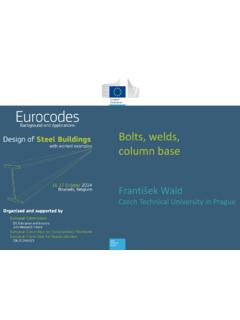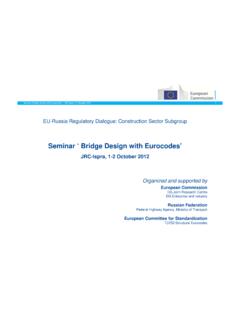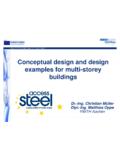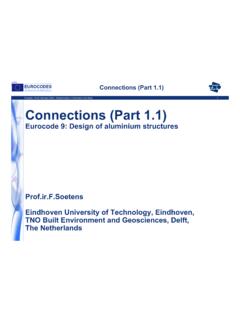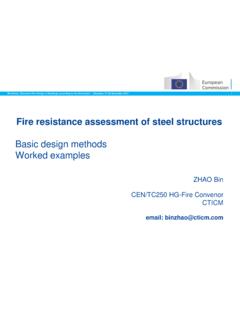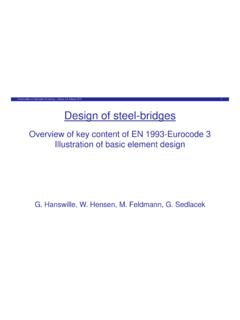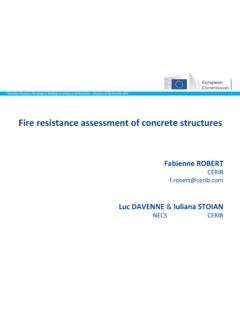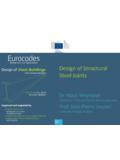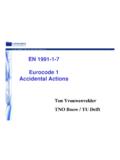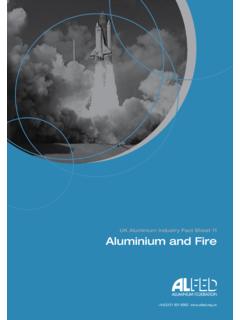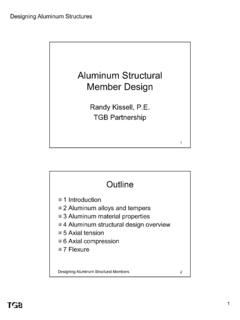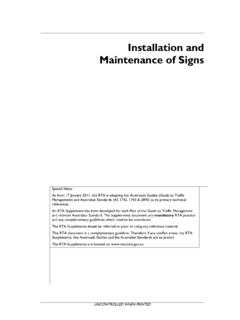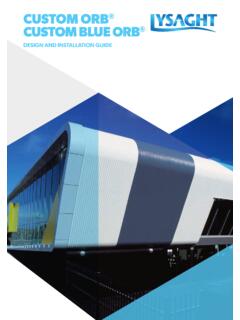Transcription of Design of Aluminium Structures: Selection of Structural …
1 Design of Aluminium Structures: Selection of Structural Alloys Structural Design according to Eurocode 9: Essential Properties of Materials and Back-ground Information R. Gitter*), GDA Gesamtverband der Aluminiumindustrie , D sseldorf/Germany Paper presented at the workshop in Brussels: EUROCODES - Background and Applications- Session EN 1999-Eurocode 9: Design of Aluminium structures; 20. February 2008**) Summary Aluminium has in fact proved itself as a suitable material for load bearing structures for more than one hundred years. However certain knowledge of Aluminium is necessary to Design struc-tures. In combination with the materials and material provisions of EUROCODE 9: EN 1999, the task of this paper is to cover the most important aspects needed to Design in Aluminium . It cov-ers the important differences in physical properties compared to steel which need to be under-stood to Design Aluminium structures.
2 It covers the influence of heat on the mechanical proper-ties of Aluminium . The essential metallurgical aspects are explained to enable understanding of Aluminium 's nomenclature system for alloys and their temper designations. It deals with the al-loys, listed in EUROCODE 9, gives background information and advice for their Selection and application for structures. In particular the topic Design of extruded profiles and material selec-tion combined with this is treated in a special section. In Annex C fields of application are listed where the Eurocode 9 is the (legal!) basis for the Design or where the code is commonly used or can be used for the Design . 1. Introduction 2. Hardening of Aluminium General Alloy hardening Work hardening Precipitation hardening 3. Alloys General Designation of wrought alloys Designation of casting alloys Numerical and chemical designation of alloys 4.
3 Tempers and designation of tempers General Tempers of non-heat-treatable alloys Tempers of heat-treatable alloys 5. Alloys and tempers listed in EC 9 General Wrought alloys Casting alloys 6. Practical viewpoints for the Selection of materials Sheet, plate and extrusions Cast and drop forged parts 7. Physical properties essential for Design General physical properties Influence of heat 8. Application of Aluminium in the future Annex A: Comments and explanations to material properties and mate-rial provisions given in EN 1999-1-1. Wrought alloys General Tabled values for sheet materials, table Tabled values for extrusion materials, table . Tabled values for forging materials, table Other provisions Casting alloys General Tabled values for casting materials, table Design and quality provisions Annex B: Drafting extrusion profiles and choice of alloy General rules for the Design of sections Rules for round tubes and tube-like sections Materials Annex C: Fields of application for the Eurocode 9 Acknowledgment and references *) Reinhold Gitter, AluConsult, Kirchstrasse 19, D 78244 Gottmadingen/Germany Email: ; **) Corrected and amended in august 2008 R.
4 Gitter; Selection of Structural alloys; Brussels 2008 (5c); 2 1. Introduction Engineers familiar with steel charged with designing an Aluminium structure are faced with two particularities. The first is the large number of alloys combined with the different so called tem-pers which are available. The second, and this may be a problem, is the fact, that as either sheet or standard section only a limited range of alloys are available from stock. An adherent problem is the fact that the range of sections available from stock is very limited and confined to small shapes although a few stockists also have a few medium sized sections. The reason for this is that the processes for producing steel sections usually involves rolling whereas in con-trast Aluminium sections are usually manufactured by warm extrusion. Rolling is characterized by high roll die costs in combination with considerable changeover times and therefore needs large production quantities for economic manufacture of one section.
5 Aluminium extrusion die costs vary between low for small sections and moderate for the large shapes. The quantities to economically produce an Aluminium section are relatively small and lie between 200 kg and 3000 kg, depending on size of section. The consequence is that many engineers and compa-nies Design their own sections which are specific for the structure and are designed often with a high functionality. Ninety percent of all sections produced by Aluminium extruders are individu-ally designed and are therefore only available for the use by the designer/purchaser of the sec-tion. This explains the special stock situation which applies to Aluminium sections and why no standards for so called standard sections (FLUTZ) exist. For the experienced engineer the choice of alloy and temper is not very difficult, especially after the clarification of the following points: Which level of strength is needed?
6 Is high welding strength really necessary? (Or: Is it possible to avoid welding at distinct loca-tions, may depend on size of sheet available) Which form of semi product is needed: sheet/plate/extrusions? What are the quantities needed are they available from stock? Are individually designed sections of quantities sufficient for production? Are filigreed/multi-hollow sections of advantage or needed? Is there a need for high ductility material? Is bendability/formability of sections needed? Is foldability/formability for sheet material required? Is decorative anodisability necessary? Is exceptionally good corrosion behaviour required (for special applications)? Are there special requirements with respect to elevated temperatures? Last but not least, what will be the materials cost? There are considerable differences between the various alloys and the semi products and often the engineer is forced to change the Design to make cost compromises.
7 This may explain why the engineer designing in Aluminium needs to know much more about the material Aluminium itself especially when compared to the steel designing process. This also concerns some physical properties which are different for Aluminium than for steel. The paper deals with all these questions and also gives background knowledge of rules and provisions given in EC9 concerning material. In EN 1999-1-1 in Annex C some information about material questions is already given, these chapters help but are not really enough. R. Gitter; Selection of Structural alloys; Brussels 2008 (5c); 3 2. Hardening of Aluminium General Pure Aluminium itself is a metal with relatively low strength. Aluminium in its purest form has a tensile strength of around 40 N/mm and a proof strength of about 10 N/mm . For most technical applications this is too low. Aluminium alloys however have been developed with mechanical properties far in excess of those of the base material.
8 In all solid metals plastic flow in the individual crystals of the material occurs along specific slip planes. These slip planes offer the lowest resistance to internal shear stresses and at the atomic level shear movement occurs along these planes without any separation of the material. If a metal is strained over its elastic limit it begins to flow and permanent plastic deformation oc-curs. When subjected to loads above the material's elastic limit tensile test specimens become longer and thinner. In the material many of such shear planes appear. Since the commercial al-loys, when considered macroscopically, are generally fine grained and relatively isotropic, the shear planes are inclined at approx. 45 corresponding to the plane with the highest shear stress. For the engineer, thinking in mechanical terms, it is easy to appreciate that an improvement of the shear strength should also improve the general mechanical strength of the metal.
9 The idea that this can be achieved by use of structures which act like shear dowels is not so very wrong and is a help in understanding the various differing methods of hardening Aluminium . The basic principle is that all types of lattice imperfection can cause an increase in shear strength. Alloy hardening A very efficient means of producing lattice imperfections is to introduce suitable foreign ele-ments into the Aluminium matrix. To a certain degree their efficacy depends on the difference in atomic radii between the foreign element and Aluminium . The relationship between the content of added foreign element and the hardening effect is not linear, as can be seen from Fig. 1. Figure 1: Hardening effect as a function of the content of alloying element One of the elements which best suits the requirement to improve strength is magnesium. There-fore Aluminium -magnesium alloys were the predominant choice for Structural Aluminium applica-tions 100 years ago and were still so many years later.
10 High strength values in alloys with up to 10 percent magnesium were available. However, problems when hot and cold working these alloys and the less than optimum corro-sion behaviour of the alloys with very high magnesium levels, led to the gradual adoption of al-loys with lower amounts of magnesium but with additions of manganese. R. Gitter; Selection of Structural alloys; Brussels 2008 (5c); 4 In Fig. 1 the curve for the frequently used alloying element, manganese, is not shown. Manga-nese itself as a single alloying addition has only a limited importance with respect to hardening. In combination with magnesium, however, it is much more effective. In addition corrosion be-haviour is improved. Work hardening Plastic deformation produces imperfections in the lattice by markedly increasing the numbers of so called "dislocations" particularly along the slip-planes. With increasing load and deformation, additional slip planes continuously develop so that, with the resulting increase in dislocation density, the material develops increased mechanical strength.
